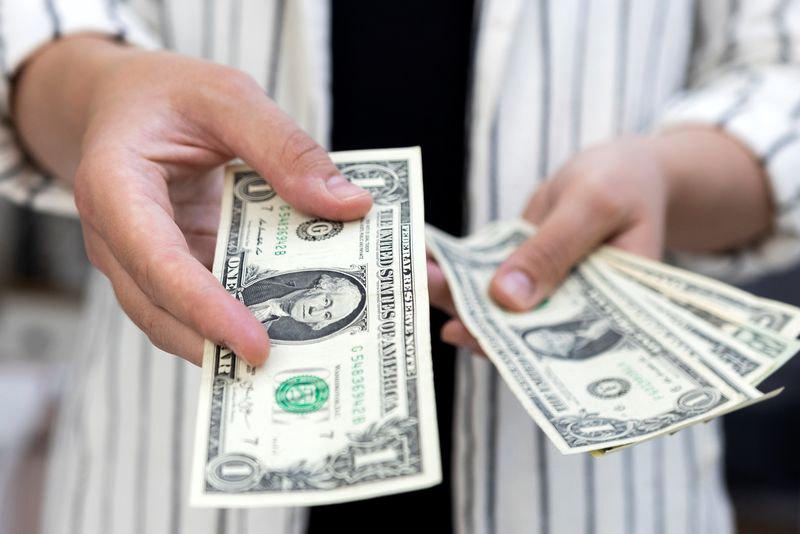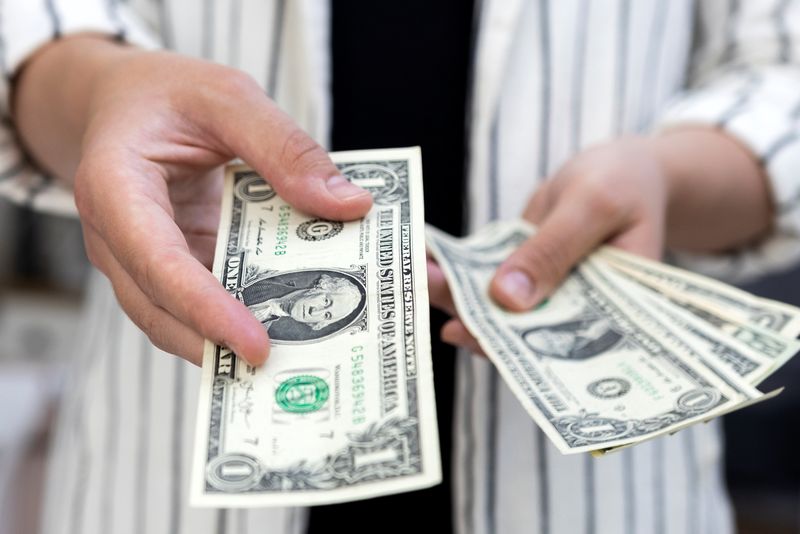Forex
Dollar strengthens after big shift in global rate outlook


© Reuters. FILE PHOTO: Woman holds U.S. dollar banknotes in this illustration taken May 30, 2022. REUTERS/Dado Ruvic/Illustration/File Photo
By Herbert Lash and Amanda Cooper
NEW YORK/LONDON (Reuters) -The dollar headed toward a second week of gains on Friday, after a slight rate hike in Japan gave the yen a slight reprieve and a surprise cut in Switzerland highlighted the gap in interest rate policy between the Federal Reserve and other central banks.
The week marked a shift in global monetary policy as the Swiss National Bank (SNB) and central banks in developing countries cut rates or indicated their intention to do so, with June the likely moment for the European Central Bank to move.
The dollar rose against all G-10 currencies except the yen, as the relatively strong U.S. economy and high interest rates kept the carry trade alive. But the Swiss rate cut, the first by a major central bank in Europe, marked a definitive shift.
“We had a somewhat surprising cut from the SNB this week,” said Shaun Osborne, chief FX strategist at Scotiabank in Toronto. “People have been extrapolating, certainly from a signaling point of view, what that might mean for other central banks in Europe.”
The Fed left its overnight rate on hold between 5.25%-5.5% and stuck with projections for three cuts by year’s end. But it also said it would not cut until it was confident that inflation was sustainably declining toward its 2% target.
About 84 basis points of cuts are priced in for this year – much lower than the 160 or so at the start of the year – but higher than earlier in the week as rate cut bets gained steam.
Sterling dropped 0.5%, hitting a one-month low at 1.258, after a 1% drop on Thursday when the Bank of England left rates unchanged. But the BoE revealed a more dovish tilt as two hawkish committee members dropped their prior call for a hike.
“What happened out of the SNB and what happened with the BoE really opening the door to rate cuts earlier than expected, that’s putting the dollar in a better light,” said Marvin Loh, senior global macro strategist at State Street (NYSE:) in Boston.
“Things are calm, but the dollar is a little bit stronger.”
The Swiss franc, the best performing G10 currency of 2023, has lost about 1.7% in value against the dollar this week and about 6.8% so far this year.
The , a measure of the U.S. currency against six major trading partners, rose 0.45% while the dollar weakened 0.12% against the Japanese yen at 151.44 per dollar.
The dollar is up about 1.5% this week versus the yen after approaching levels that prompted Japanese intervention in 2022.
Euro/yen hit its highest since 2008 this week at 165.37 and the broke above 100 yen for the first time since 2014.
With the dollar in the ascendant, the euro hit a three-week low. It was last trading down 0.5% at $1.0806.
The Bank of Japan announced an historic shift out of negative short-term rates and longer-run yield caps, but it was so well telegraphed that the yen fell on the news.
Expectations for policy easing in China too have piled pressure on its currency, which dropped sharply in the onshore session, spooking equity investors and prompting state banks to step in. [CNY/][MKTS/GLOB]
It was last at 7.229 per dollar, while in offshore trading the dollar headed for its largest one-day rise against the yuan in a year, up 0.77% to 7.2769.
was set for its largest weekly drop since last August, with a roughly 6.7% fall, as crypto markets have taken a step back from a powerful rally this week – though it will trade through until Sunday.
It was last down 2.74% at $63,674.36, having fallen by some 13% since a record high close to $74,000 last week.

 Forex3 years ago
Forex3 years agoForex Today: the dollar is gaining strength amid gloomy sentiment at the start of the Fed’s week

 Forex3 years ago
Forex3 years agoUnbiased review of Pocket Option broker

 Forex3 years ago
Forex3 years agoDollar to pound sterling exchange rate today: Pound plummeted to its lowest since 1985

 Forex3 years ago
Forex3 years agoHow is the Australian dollar doing today?

 Cryptocurrency3 years ago
Cryptocurrency3 years agoWhat happened in the crypto market – current events today

 World3 years ago
World3 years agoWhy are modern video games an art form?

 Commodities3 years ago
Commodities3 years agoCopper continues to fall in price on expectations of lower demand in China

 Economy3 years ago
Economy3 years agoCrude oil tankers double in price due to EU anti-Russian sanctions





















